|
Oregon Eastern Railroad Oregon Eastern Division of the Wyoming/Colorado Railroad |
||||||||
|
|
||||||||
|
|
||||||||
|
Oregon Eastern Division locomotive #1608 resting in the Vale yard in 2003. Photo by and courtesy of Geoffrey Barnes. |
||||||||
|
|
||||||||
History When the Union Pacific suspended service over its Burns Branch due to the flooding of Malheur and Harney Lakes in March 1984, the company announced intentions to re-build the damaged trackage and resume service as soon as the flood waters receeded. However, when the lake levels dropped in the late 1980s the company made no efforts to repair the line. One of the biggest stumbling blocks to repairing the line was the large amount of work needed and the high cost of performing the work. The rail line was seen by many as an essential part of the region's economy, and cries to get the railroad re-opened again became louder and more frequent. Three shippers were located in Burns at the time; Snow Mountain Pine, successor to the Edward Hines Lumber Company (see the Oregon & Northwestern page on this website), Tecton Laminates, and Frenchglen Millworks. Following the 1984 closure of the line these shippers trucked their products to other reloads in the vicinity, including one that was briefly established on the Great Western Railroad in Lakeview, OR. Trucking the lumber out of the basin added to the operating costs of all three companies, making them less competative in the lumber markets. In 1986 Union Pacific decided to sell 87 branchlines across its system to shortline operators. The Burns branch was one of the lines offered up. A group of companies based out of Boise, ID formed an organization called Intermountain Western Industries, and a deal to buy the Burns branch as part of a bigger package deal including 319 miles of branchlines in southern Idaho was soon signed. Intermountain Western Industries created the Intermountain Western Railroad to operate the lines, and several locomotives were acquired and painted for the new operation. |
||||||||
|
|
||||||||
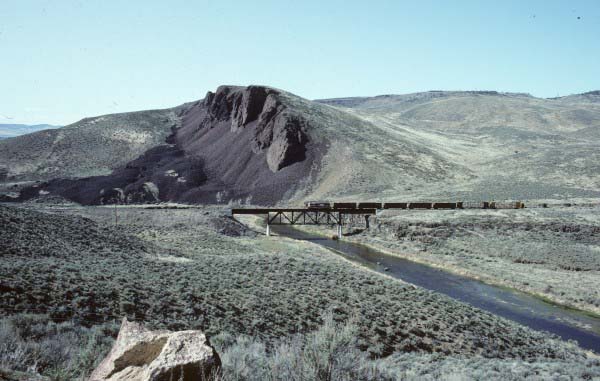 |
||||||||
|
#1608 leading a westbound freight across the Malheur River. Photo by and courtesy of John E. Shaw, Jr. |
||||||||
|
|
||||||||
|
Efforts to secure public funding to rebuild the damaged trackage across the lake were started while the
Intermountain Western deal was being worked out. Local and state politicians appealed to the Army Corps
of Engineers for funding to repair the railroad, but the Corps issued a report in June 1987 denying the
application. The Corps concluded that the railroad was a single property, and the regulations prohibited
the agency from funding projects benefiting only one property. The agency then released a Final Environmental
Impact Statement that disapproved of any publicly financed repairs. This negative report spurred Oregon's
Congressional delegation into action, and the agency was pressured to change its decision. Robert Page, Assistant
Secretary of the Army, soon issued a decision determining that the project was in the public interest and
that it should be funded under Section 205 of the Flood Control Act of 1948. Congress authorized $3 million
for the project on 15 December 1987. The Corps went back to work on another Environmental Impact Statement.
The first draft of this document issued to the public on 6 September 1987 called for the railroad to be
raised from 3 to 6 feet. The Corps estimated that the public investment in the line would be earned back
through higher Forest Service timber sale receipts from the area, as there was a feeling that the lack of
rail service caused timber sales to sell for less than they could have with readily available rail service.
The Forest Service pegged their annual losses attributed to the lack of rail service at $1.9 million In late 1987 negotiations between Union Pacific and Intermountain Western Industries broke down, and the agreement to sell the Burns branch fell apart. Once again the future of the line became cloudy. One of the companies behind Intermountain Western Industries was Western Railroad Builders (WRB) of Ogden, Utah. WRB was a railroad contracting firm that got into the shortline railroading business with the purchase of two Union Pacific branchlines in southern Wyoming and northern Colorado. The company established the Wyoming/Colorado Railroad (WYCO) to operate the branches. WRB became interested in the Burns branch after the Intermountain Western deal fell apart, and after receiving traffic assurances from potential shippers in Burns the company entered into negotiations with UP for the line. A deal was reached in late 1988, and the Interstate Commerce Commission approved the sale on 13 April 1989. WYCO expected to earn a profit by operating the line so long as the reconstruction of the damaged track did not cost the company anything. Snow Mountain Pine projected shipping 150-200 carloads of lumber per month over the re-opened railroad. WYCO believed that it could successfully operate the line with that level of business, but some lingering doubts about the viability of the line remained. WYCO signed an agreement with the State of Oregon committing the company to provide service to Burns for at least three years, as all sides realized that bringing traffic back onto the rails would not happen overnight. WYCO planned to operate the line indefinately, but secured a right to terminate operations and salvage the line if insufficient traffic to keep the line going was not realized at the end of three years. |
||||||||
|
|
||||||||
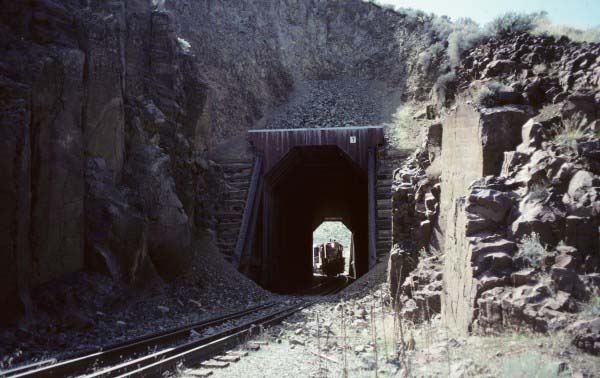 |
||||||||
|
#1608 about to enter Tunnel #7. Photo by and courtesy of John E. Shaw, Jr. |
||||||||
|
|
||||||||
|
Negotiations between the various involved parties dragged on
through the summer and fall of 1989. WYCO's deal to purchase the line from Union Pacific finally closed in
early November, and the Oregon Eastern Division of the Wyoming/Colorado Railroad commenced operations on
6 November 1989 over the 24 miles of track between Ontario and Celatom. A burned trestle and collapsed tunnel
had to be repaired on the line between Celatom and Crane in addition to the work required on the line west
of Crane. Local and state politicians put together a funding package to finance the work on the line west of Crane. Most of the funding came from the $3 million appropriated by Congress earlier; the three lumber mills in Burns contributed $200,000 towards the project; and additional funds were provided by the State of Oregon and local governments. WYCO was to do the actual work, but ran into snags over financing methods. The Army Corps of Engineers required WYCO to post $3.5 million dollars worth of performance bonds before the work began, but the company was unable to secure such bonds. WYCO did obtain over $7 million worth of surety bonds, but the Corps refused to accept them. WYCO sent a letter to Oregon Congressman Robert Smith stating that they would salvage the rails if a resolution to the stand-off could not be found quickly. Mr. Smith called a meeting with the Corps, and after the intervention of the Congressman the agency agreed to accept WYCO's surety bonds. The last obstacle to re-opening the railroad was cleared. Work on the reconstruction project commenced during the third week of November 1989. WYCO brought in a crew of 22 men to do the work, which involved dumping rock down the middle and along the sides of the track. A track machine would then run over the track, lifting the track structure up and compacting the rock underneath. Approximately a mile and a quarter of new track was laid in areas where the lake had washed the old track structure away. Re-building the damaged track consumed 70,000 cubic yards of rock, and 1,500 feet of culvert pipe was installed in the grade to allow for safe passage of water under the tracks. The tracks were raised an average of around 6 feet, with some areas requiring fills up to 10 feet deep. The first train into Burns arrived during the last week of January 1990, and the first revenue train eastbound out of Burns left town with three loads of Snow Mountain Pine lumber in the pre-dawn hours of Friday, 2 February 1990. The dream of resuming service to Burns was finally a reality. WYCO stationed a train crew in Burns, and twice a week the crew ran eastward. WYCO continued to operate the eastern portion of the line with locomotives leased from the Union Pacific. |
||||||||
|
|
||||||||
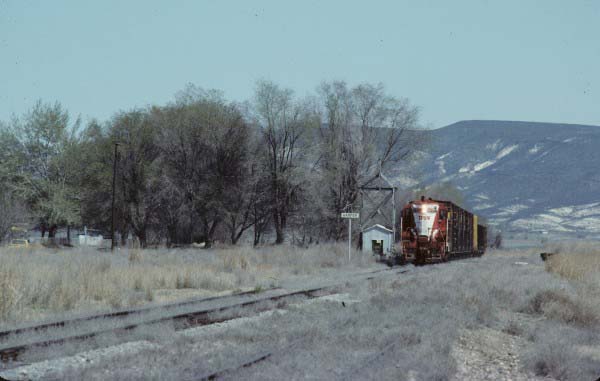 |
||||||||
|
#1608 leading a train through Harper. Photo by and courtesy of John E. Shaw, Jr. |
||||||||
|
|
||||||||
|
Work on improving the railroad continued through the spring and summer, and by early June the job was
nearly done. It was time to party. Thursday, 31 May 1990, was the chosen day for the Great 1990 Rerailment
Celebration. Approximately 100 celebrants paid $25 each to ride a four car passenger special on that day
that ran from Crane over the rebuilt trackage to Hines. A steak barbecue was held after the train arrived
in Burns. Many politicians and dignitaries gave speeches, and everyone had a good time. Despite the prevailing optimism there were some troubling signs. Snow Mountain Pine projected that they would ship 150-200 loads a month before operations began, but actually only shipped a grand total of 86 cars during the first four full months of operation. Tecton Laminates shipped one carload during that same period, and Frenchglen Millworks contributed a carload or two a week. It was not nearly enough. WYCO responded by dropping service down to one train a week, and by the end of 1990 Burns-based operations were abolished, with trains operating from Vale out to Burns only when enough enough loaded cars were available to make a run worth it. The sawmills felt that they could get their customers to accept freight shipped by rail again, but despite the best efforts of everyone involved carloadings remained flat. Service to Burns dropped to an average of one train every three weeks. Traffic over the eastern end of the railroad remained good. The primary shipper on this part of the railroad was a giant Eagle-Pitcher Diatomaceous Earth plant located at Celatom, 24 miles west of Ontario. The railroad also did good business hauling agricultural commondities over this end of the railroad. West of Celatom was another story, as traffic failed to improve. WYCO was free to end operations west of Celatom in the early months of 1992, and as that date grew near the public agencies that financed the re-opening or the line grew concerned. The parties assumed that three years would provide enough time for WYCO to build a traffic base to allow for profitable operations, but the traffic base did not appear. The State of Oregon announced in late 1991 plans to build a woodchip loader in either Burns or Hines that would provide an estimated 20 to 30 loads a week for the railroad, but nothing came of those plans. Average carloads handled to or from Burns held steady at around 25 per month as 1991 turned into 1992. WYCO's commitment to the State of Oregon was met in mid-March, but the railroad continued running to Burns in the hope that a substantial new source of traffic would show up that would save the public and private investments in the line. The line was in a precarious situation, and only one small mishap was required to force the issue. That one mishap came in June 1992, when heavy truck traffic severely damaged the Highway 78 grade crossing in Crane, making it almost inpassable to rail traffic. WYCO decided that the end was at hand. On 23 June 1992 a light locomotive made the long trip from Vale to Burns to gather up all remaining cars at the west end of the railroad. The final eastbound train departed in the early morning hours of 24 June 1992. This last train consisted of two loads from Tecton Laminates, three empty boxcars, and two empty bulkhead flats. The crew for this last run consisted of engineer Todd Torgesen and conductor Ron Ashworth. A hi-rail pickup driven by Rocky Wensenk carrying all remaining track and equipment tools formerly used on the west end of the railroad followed the last freight out of town. A track bulletin was issued on 1 July 1992 taking the entire railroad west of Celatom out of service. |
||||||||
|
|
||||||||
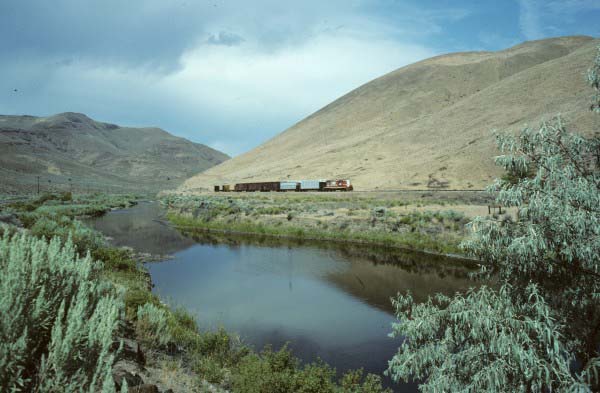 |
||||||||
|
#1608 heading east with loads at Namorf. Photo by and courtesy of John E. Shaw, Jr. |
||||||||
|
|
||||||||
|
The railroad put the word out that it would run to Burns again if the shippers ordered cars, but no orders
were received. In late August 1992 workers at Snow Mountain Pine discovered a track crew commencing
salvage operations next to the Hines mill. The state and local governments protested, but to no avail as
WYCO had the right to take up the tracks. Salvage operations began in earnest the following spring, and by
the middle of 1993 the 30 miles from Crane to Burns had been removed by A&K Rail Materials, a salvage
firm. At this point Union Pacific took WYCO to court, claiming that the short line had violated the three
year operating contract for the line. UP claimed that it had the right to reacquire the line for the
original $1.3 million purchase price and that WYCO had to turn 60% of the salvage value of the tracks already
removed over to the UP. The case dragged on through the last half of 1993 and into the early months of
1994, when WYCO and UP reached an agreement settling the case. Under the agreement WYCO got to scrap the
line from Milepost 78 (about four miles west of Juntura) westward to Burns, while UP got to scrap the 44
miles of track from Celatom to Milepost 78. WYCO sold their portion of the tracks to A&K Rail Materials,
and the job of scrapping the railroad from Crane to Milepost 78 commenced on 7 January 1994 and was
completed on 1 February 1994. A&K established a temporary yard in Celatom to hold the rails from
their stretch, and the ties were removed and trucked to Klamath Falls, OR, for disposition. A UP track
crew commenced scrapping operations on their portion of the line on 6 Febrary 1994, and their job was
done by the end of March. The UP rails were loaded into eight rail trains that were shipped east to
UP plants for conversion into continuously welded rail. Thus ended the long and sometime strange tale of railroading in the Harney basin. There was a lot of talk of placing the railroad into public ownership to preserve it for possible future use, but feelings ran against dumping any additional public money into the line. There was a lot of talk of turning the grade into a recreation trail, and WYCO donated the grade from Hines to Burns to an organization proposing to start a trail, but nothing came of that idea either. Despite the huge expenditures of public funds and political capital the line could not be saved. Snow Mountain Pine closed the mill in Hines in 1995, which would have doomed the railroad anyway. Most of the sawmill facility has been scrapped, with little more than the smokestack, parts of one of the drying sheds, and a few outbuildings remaining today. Louisiana Pacific continued operating the old Tecton Laminates facility until 2007, when it too closed. |
||||||||
|
|
||||||||
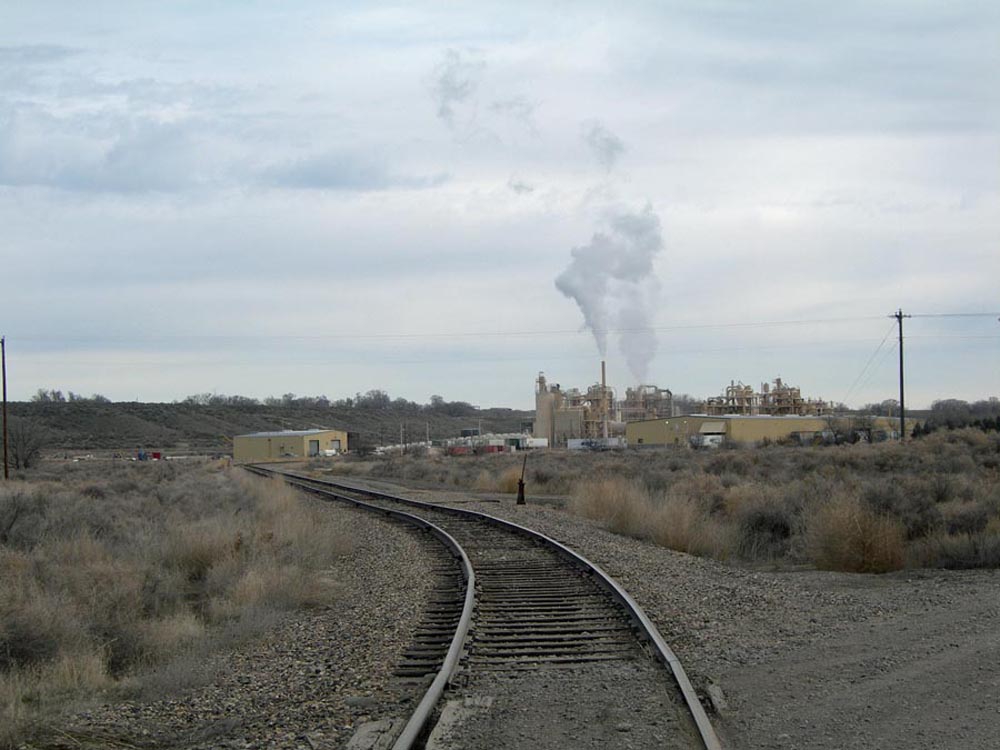 |
||||||||
|
The EP Minerals plant in Celatom. Jeff Moore photo. |
||||||||
|
|
||||||||
|
Western Railroad Builders eventually abandoned both of Wyoming/Colorado Railroad's original lines in those states, and
in July 2011 the company set up the Oregon Eastern Railroad as its own company. In October 2020 Western Railroad Builders
signed a deal to sell the OE along with four of its other shortlines scattered across the west to OPSEU Pension Plan Trust
Fund; Jaguar Transport Holdings, LLC; and Jaguar Rail Holdings, LLC. OPSEU manages one of Canada's largest pension funds and
interectly controls the the two Jaguar companies. The five shortlines included in the transaction will join one other owned
railroad, the West Memphis Base Railroad LLC in Arkansas. The OE under both ownerships continues to operate the eastern 24 miles of the railroad from their base in Vale, Oregon. Two shippers dominated the traffic base after 1992. Diatomaceous Earth shipped by the EP Minerals plant at Celatom provided most of the freight traffic, supplemented by Farmers Supply Cooperative that receives carloads of fertilizer in Vale and LPG at Claude. In recent years the railroad gained a major new customer when Lineage Logistics started operations cleaning and servicing refrigerator cars in Vale, the Oregon Eastern receives and stores the cars until Lineage is ready for them, after which the cars are delivered back to the Union Pacific for spotting at the massive Americold in Ontario for loading. Jaguar shortly after buying the railroad built the Robert E. Hunt Memorial Transload in Vale that initially is receiving carloads of lumber and LPG for distribution to points all over the Treasure Valley, which returned lumber traffic to the railroad after an absence lasting thirty years. In response to this new traffic UP granted the Oregon Eastern permission to operate over their mainline from Malheur Junction north to the Ontario yard to better facilitate the interchange of cars between the two roads.. |
||||||||
|
|
||||||||
 |
||||||||
|
The #1608 switching refrigerator cars in Vale in May 2021. Luke Noltensmeyer. |
||||||||
|
|
||||||||
 |
||||||||
|
Refrigerator cars parked at Luse Siding west of Vale awaiting their turn for servicing. Luke Noltensmeyer. |
||||||||
|
|
||||||||
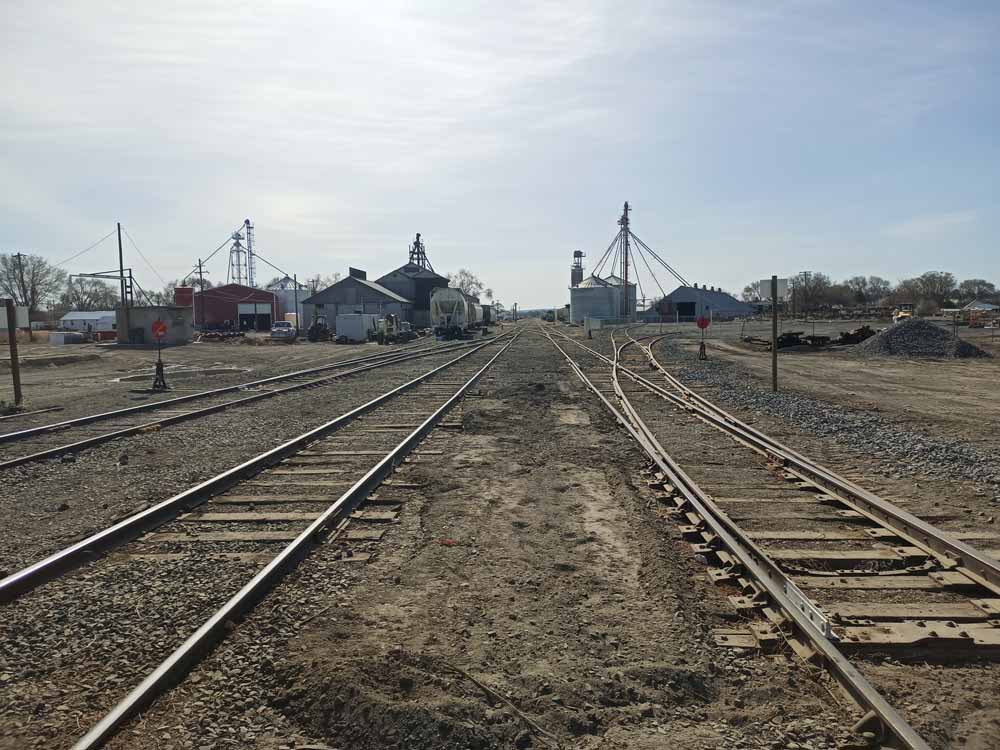 |
||||||||
|
The new reload tracks built in the spring of 2022 are off to the right. Luke Noltensmeyer. |
||||||||
|
|
||||||||
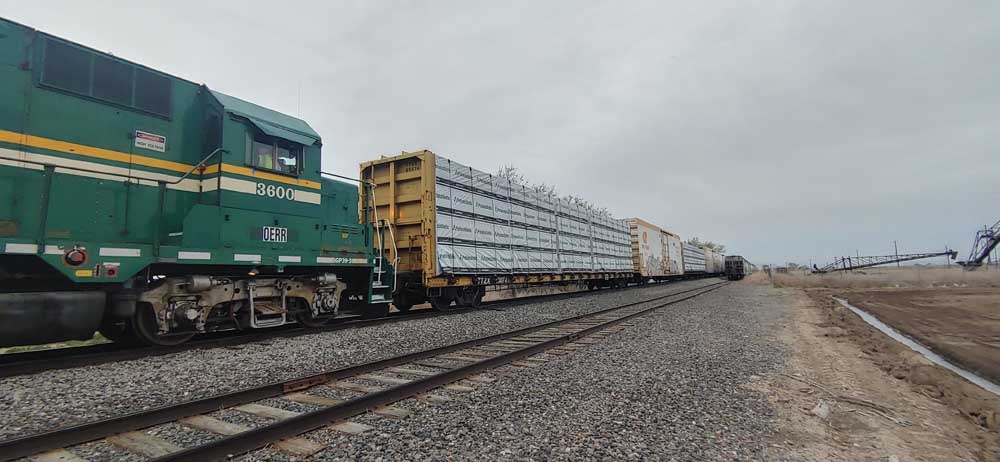 |
||||||||
|
The first lumber loads the railroad handled since suspending operations to Burns arriving on the railroad. The cars are destined for the new reload in Vale. Caden Wood photo. |
||||||||
|
|
||||||||
|
Maps 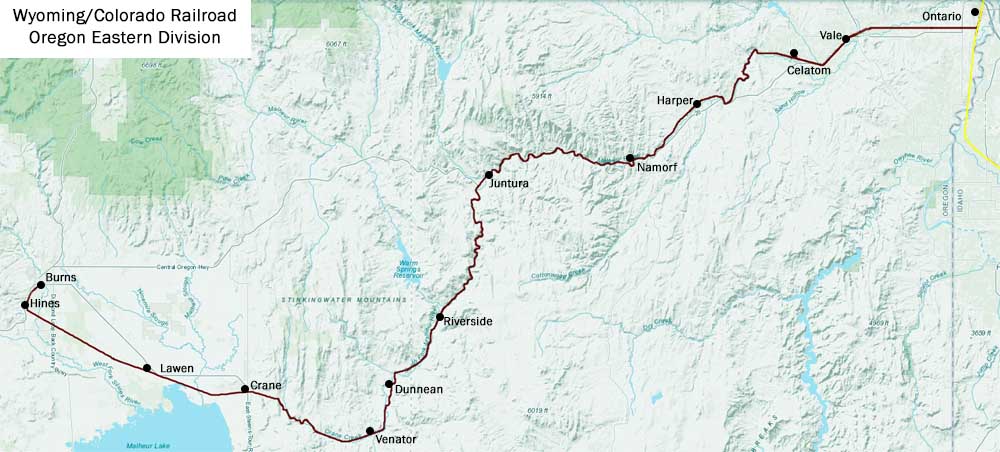 |
||||||||
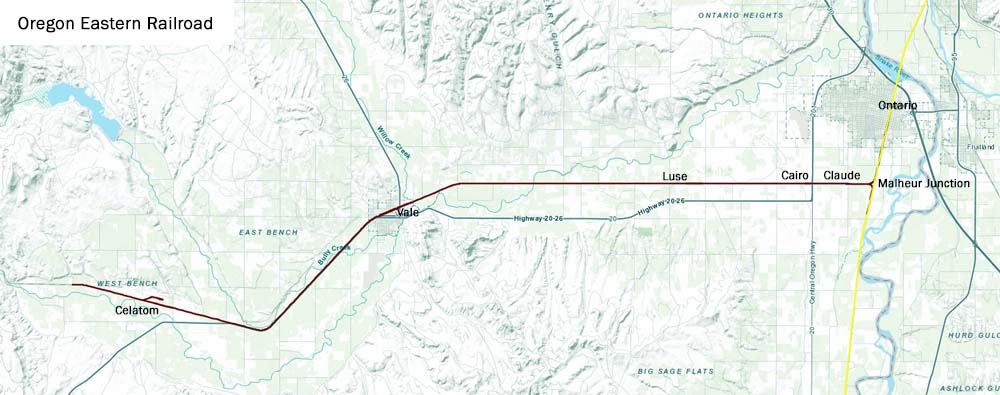 |
||||||||
|
|
||||||||
All time locomotive roster Underlined numbers indicate a link to a page of pictures of that locomotive. #1608- Elecro Motive Division of General Motors (EMD) model GP-7, c/n 15634, built January 1952. Originally Toledo, Peoria & Western #102; to Michigan Northern Railroad #1608 1983; initially leased to and later sold to Wyoming/Colorado Railroad. Used on the WYCO line out of Laramie, WY until late 1990, when it moved to the Oregon Eastern Division. Re-built with a new cab and a chopped nose in 1994/1995. To Western Rail 2021. Scrapped in Vale spring 2022. #2072- EMD model GP-7, c/n 18905, built December 1953. Rebuilt in June 1974 at Atchison, Topeka & Santa Fe's Cleburne, Texas, shops. Originally AT&SF #2888, re-numberd AT&SF #2072. To Grand Canyon Railway #2072 1989; to Southwestern Railroad #2072; to Oregon Eastern Division of Wyoming/Colorado 1997. To Western Rail 2021. Scrapped in Vale spring 2022. #2171- EMD model GP-7, c/n 13164, built October 1950. Rebuilt in October 1979 at Atchison, Topeka & Santa Fe's Cleburne, Texas, shops. Originally AT&SF #2660, re-numberd AT&SF #2171. To Southwestern Railroad #2171 August 1995; to Wyoming/Colorado, Saratoga, Wyoming, then moved to OE circa 2003 after that operation closed. To Western Rail 2021. Scrapped in Vale spring 2022. #2182- EMD model GP-7, c/n 12202, built February 1951. Rebuilt in January 1980 at Atchison, Topeka & Santa Fe's Cleburne, Texas, shops. Originally AT&SF #2674, re-numberd AT&SF #2674. To Southwestern Railroad #2182; to Oregon Eastern Division of Wyoming/Colorado. In service. #3600- EMD GP39-3, c/n 29705, built December 1964. Originally built as a GP35 for Southern Pacific as their #7703, then renumbered 1965 to #6600. Retired 16 December 1993 and sold 25 October 1995 to OmniTRAX, Loveland, Colorado. Leased to Northwestern Pacific circa 1996-1997, then used on various OmniTRAX owned railroads including Hudson Bay Railway (#2503); Central Kansas Railway (#2503); Panhandle Northern Railway (#2503); Great Western Railway (#3600); and Kettle Falls International Railway (#3600). Sold to Western Rail and rebuilt to a GP39-2, then to Oregon Eastern #3600 in 2021. In service. #6083- EMD model SD-7, c/n 17124, built March 1953. Originally Fort Worth & Denver #853, re-numbered FW&D #6083; to Burlington Northern #6083; to Iowa Railroad #6083 1983; to Wyoming/Colorado Railroad #6083 1987. Initially used on one or both of the Wyoming lines; transferred to Oregon Eastern Division in 1989. Was only locomotive on the Oregon Eastern until late 1990, when it blew its air compressor and went down. Stored at Juntura from late 1990 until early 1992, when it was brought into Vale and repaired. Powered the scrap trains that helped salvage the Celatom-Burns trackage throughout 1993 and 1994. Sent back east to Wyoming in the early part of 1994. Worked on the Laramie line until the end of operations on that line, then transferred to the Encampment Branch. Reported to have been scrapped in Saratoga, WY, in 2007. In addition to the above three WYCO has also leased a large number of locomotives from the Union Pacific, mostly EMD SD40-2s, especially in the early years of operation. WYCO also reportedly evaluated using some of the ex-Oregon & Northwestern Baldwin AS-616s at some point, but decided against using them.
|
|
Photos of the Oregon Eastern Division Great 1990 Re-Railment Passenger Special WYCO Freight Operations WYCO- Scrapping the Burns Branch UP-Scrapping the Burns Branch Burns Branch After Abandonment Oregon & Northwestern...20 Years Gone- some photos of the Edward Hines/Snow Mountain Pine sawmill complex, plus some shots of the old UP/WYCO grade, on page 1 only. Winter of 2016-2017 October 2020 Update by Luke Noltensmeyer Freight Operations in April 2021 by Matt C. Batryn-Rodriguez Freight Operations in August and September 2021 by Luke Noltensmeyer
|
|
References Books "When the Railroad Leaves Town, Volume 2: Western United States". Joseph P. Schwieterman, Truman State University Press, 2004. "Rails to the Rim: Milepost Guide to the Grand Canyon Railway". Al Richmond, Grand Canyon Railway, 1990. Periodicals "Honey, I Shrunk the Railroad; the Lonely Oregon Eastern" by John E. Shaw, Jr., November 1992 Railfan & Railroad, pgs 62-67. News Articles from the following: Pacific Rail News Burns Times-Herald
|
|
More on the Web Oregon Eastern Railroad Homepage Wyoming/Colorado Page on Shortline Rosters
|
|
|